Blog
Archives
.
. . from 2012 to current
. .
THURSDAY
MAY 14 - 2015
Mute
Swan news
I walked down
to the town millpond this afternoon after the worst of
the rain had finished. The pen swan was on the water
with her 8 cygnets still all present and healthy. The
mother swan was stirring up the mud at the bottom of
the pond with her feet to dislodge any protein rich
food for her youngsters. They are clearly starting to
feed. The cob was nearby on guard, but not really
needed.
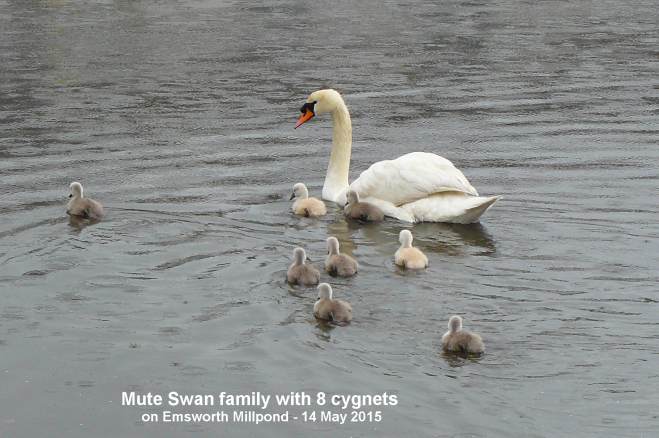
PS - Eric Eddles tells
me that the swan pair on Baffins Pond Portsmouth now
have three cygnets.
Cow
Parsley
Coming back
home through Brook Meadow it gave me great pleasure to
push my way through the overhanging panicles of Cow
Parsley that now line the main raised paths. It is one
of the great Brook Meadow spectacles at this time of
the year.
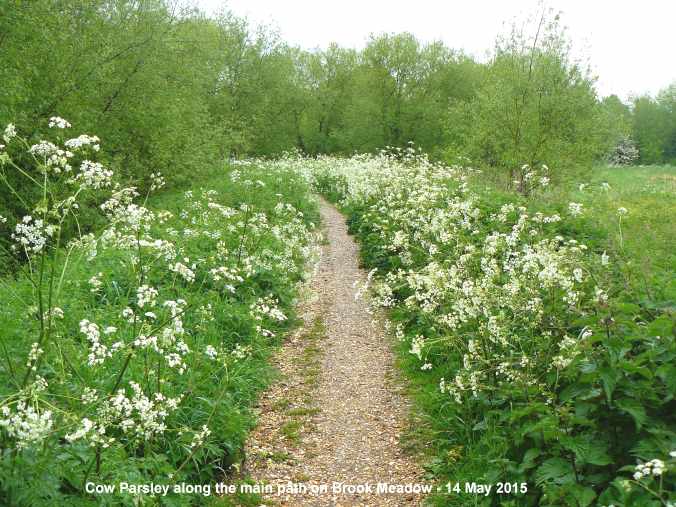
Young
Woodpigeon
We had the
first young Woodpigeon of the year in the garden
today. It differs from the adult mainly in the absence
of the white collar. It also has dark eyes, not
clearly seen in this photo; the adult has pale yellow
eyes.
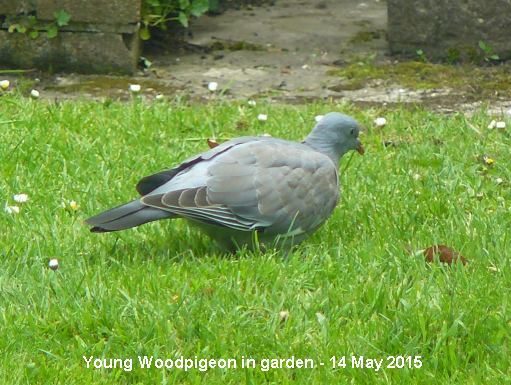
Francis's news
Francis
Kinsella had a walk through the fields between
Emsworth and Westbourne yesterday and got a couple of
excellent bird photos. On the left is a male Linnet
showing its red breast markings. On the right is a
male Green Woodpecker with red moustache
(female has no red moustache).
Francis also got this
slightly unusual shot of what must be a female
Blackcap on Brook Meadow.
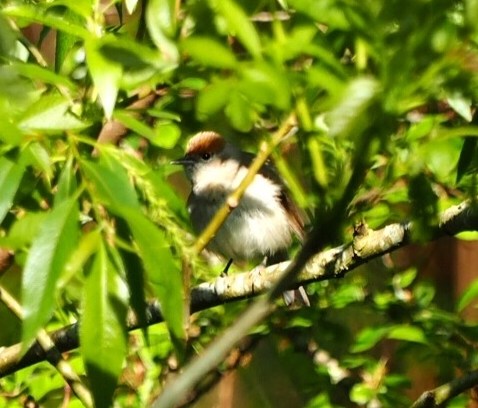
Reed
Bunting and bee
Tony Wootton
was trying to get a shot of a Reed Bunting when it
flew off. It was only when he got home and on the
computer that he noticed the presence of a bee. In the
first photo the bird is looking at the bee and in the
second it is trying to catch it.
Tony asks, Would a
reed bunting try and eat a bee? According to my book
Reed Buntings eat seeds plus insects in summer, so a
bee would seem to be an appropriate prey. I checked
with the BWP which says Reed Bunting commonly catches
flying insects, especially Odonata and Diptera, in
sallies from perch. but does not mention bees
specifically. However, with youngsters in the nest
demanding high protein food, then a juicy bee would
clearly be in order.
Hot
Sardines
Having a
snooze after a long cycle ride to Portsdown Hill
yesterday, Ralph Hollins was woken by a lively jazz
group called Hot Sardines singing "I wanna be like
you" in French on Radio 3. Ralph was so taken with the
group that he felt compelled to recommend their songs
to others as "they will take 50 years off your actual
age and revive your youth in a way that the NHS
cannot". See . . . http://ralph-hollins.net/Diary.htm
Well, that is some claim, so, on a very cold and wet
morning, Jean and I followed Ralph's advice and spent
a wonderful hour or so enjoying this lively group on
the YouTube video. We hardly danced around the room,
but at least we bounced and rocked in our armchairs!
The lead track is excellent (particularly if you are a
fan of Jungle Book), but make sure you don't miss the
black and white video with Ralph's Miss Elizabeth with
her washboard strapped to her bosom! Priceless.
Go to . . . https://www.youtube.com/watch?v=kXd9drHdkw4
Cuckoo
migration
The BTO
reports that Cuckoo migration is going well. Four
years and 55,000 miles after he was first fitted with
a satellite tag, Norfolk Cuckoo Chris has once again
returned to the UK, along with eight other
satellite-tagged Cuckoos which are all back on their
breeding grounds. See . . . http://bto-enews.org/IG4-3DTSH-3RN36S-1LC6C1-0/c.aspx
TUESDAY
MAY 13 - 2015
Millpond
News
The pen swan
was on the pond when I passed by this morning at about
11am with her 8 cygnets all still present and looking
healthy. They continue to be a major attraction to
people passing.
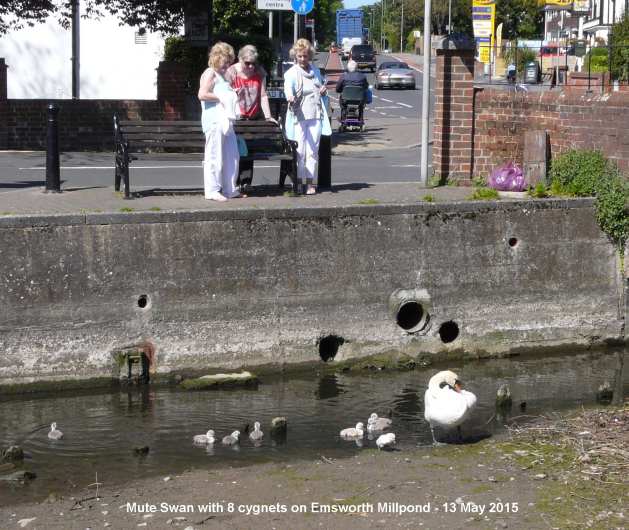
There is another very
sensible notice on the bridge informing people about
the importance of not feeding bread to the swans.
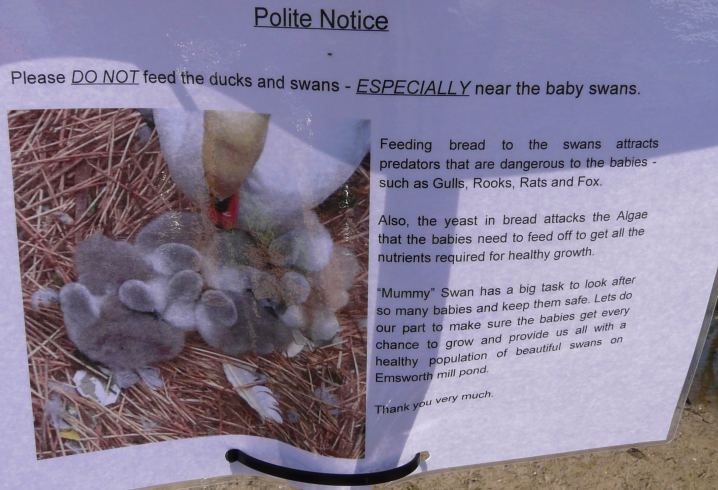
Over on Slipper
Millpond a Coot is well ensconced on its nest behind a
barricade of twigs on the north raft for a second
brood. The Great Black-backed Gull is still
sitting on the nest on the centre raft; my predicted
hatching date is May 20th - a week's time. She looks
as if she is panting in this photo - or maybe calling
for her mate?

The cob swan continues to patrol Peter Pond all alone
after having lost its mate a few weeks ago. There was
no sign of a new mate which has been mooted for a
while.
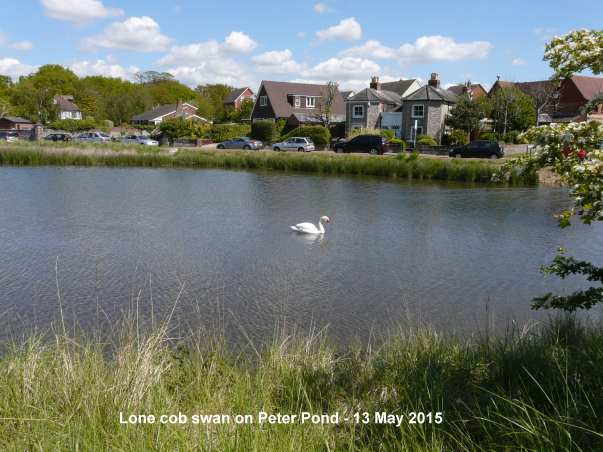
Two new plants flowering for the first time this year
on the Slipper Millpond area are Sea Club-rush
along the edge of the western path and Lesser
Sea-spurrey on the brickwork leading down to the
kissing gate near Chequers Quay.
There is also a good
growth of Lesser Swine-cress on the wall of the
Chequers Quay estate houses just north of the kissing
gate.
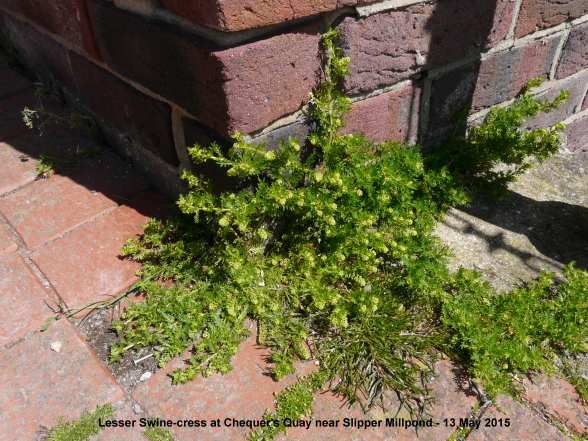
First
Ragged Robin
I had a look
around the Lumley area on Brook Meadow hoping for
Ragged Robin and, after much searching, I did
eventually find just one open flower - the first of
the year on the meadow.
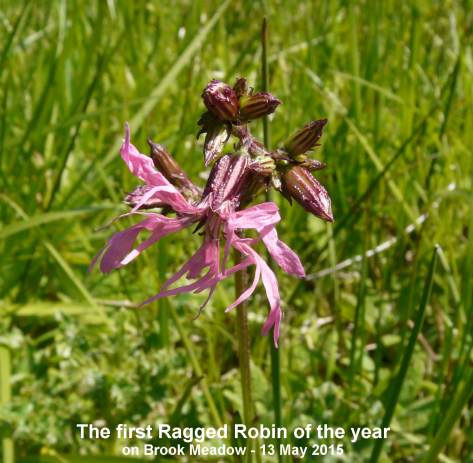
This is about a week
later than last year, though overall not all that
late. I do an annual count of Ragged Robin plants on
Brook Meadow. Last year had 104, though that pales
into insignificance compared to the record of 625 in
2010. See the Brook Meadow web site for full details
of the counts. http://www.brook-meadow.hampshire.org.uk/bm-plant-counts.html
Southern
Marsh Orchids
I had a good
look for any early signs of Southern Marsh Orchids on
Brook Meadow, but could not see anything, though it is
still a bit early. Last year they were out on May
13th, but generally we don't see them until late May.
I also had a quick look for them at Fishbourne Meadows
this afternoon, but did not see any sign there either.
However, Ralph Hollins did find a few leaves on the
South Moor at Langstone which is the main local site
for Southern Marsh Orchids.
Hairy Sedge
I found a
small tuft of Hairy Sedge growing on the north-east
path on Brook Meadow, just south of Beryl's seat and
immediately beside the Osiers. This sedge is not too
easy to find on Brook Meadow. It is rather similar in
general appearance to Distant Sedge in that it has
female spikelets distant from the male spikelets which
are located at the top of the stem. However, as the
name suggests, Hairy Sedge is hairy, both leaves and
sheaths, though you need to look closely to determine
this.
Peregrine
chicks hatched
I popped into
the Chichester Cathedral cafe this afternoon to check
on the progress of the Peregrines which are nesting in
one of the Cathedral turrets. The RSPB volunteer told
me three of the eggs had hatched successfully and they
were waiting for the fourth one. To watch the
Peregrine nesting live go to . . . http://www.chichestercathedral.org.uk/whats-on/cathedral-peregrines.shtml
Turtle
Doves
I had my first
report of Turtle Doves of the year from Sue Woodward
who has heard two singing from her new Shepherd's hut
near the two cottages in the far north-east corner of
the Stansted estate near the cottages. Note for
members of the Havant Wildlife Group that is where
Sonya used to live. Sue says she will be putting out
seed for the Turtle Doves on the recommendation of
Chris Packham!
Greetings
from Findhorn
Richard
Somerscocks sends his greetings from Findhorn in
Northern Scotland where he now lives. Richard says he
looks at this Emsworth wildlife site from time to time
just to see what is happening in his old town. Richard
of course was a major contributor to the wildlife
diary until his move to Scotland in 2012. He was
particularly pleased to see the Spotted Redshank had
returned to Nore Barn for the 11th year running.
He thought we might be interested to hear that they
currently have a Spotted Redshank that has stopped off
on Findhorn Bay, presumably on its way back to its
breeding grounds in northern Scandinavia or Arctic
Russia. He does not think it is ours as it is rather
camera shy and is quite happy to mix with the local
Redshank! However, as shown in Richard's photo it is
quite a striking bird in its summer breeding plumage.
You can see why it is called a Spotted Redshank - we
never see them like that down here.
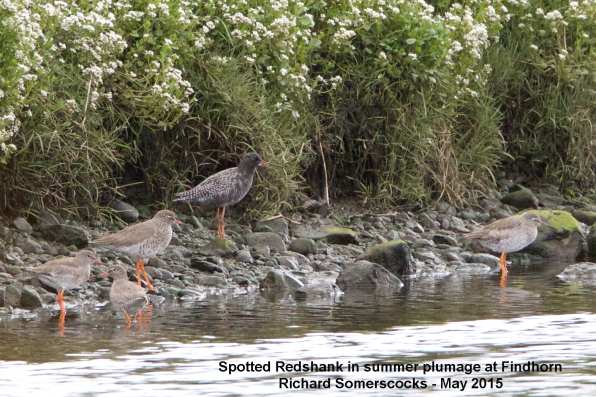
We do, in fact, have a
special page for Richard's observations and photos
from Findhorn on this web site.
Go to . . . Findhorn
News
MONDAY
MAY 11 - 2015
Waysides
News
I met Jane
Brook this morning for a short tour around some of the
local waysides.
We started by having a look at the Christopher Way
verge where we found a couple of Wild Clary
plants just surviving on the main wayside, one of
which was starting to flower. The Wild Clary that had
been in flower on the grass verge further south when
Ralph Hollins visited on May 3rd have been mown by
Council workers. Jane will consider putting up a sign
asking for these rare plants not to be mown with the
rest of the verge.
This
is what Wild Clary looks like in its prime
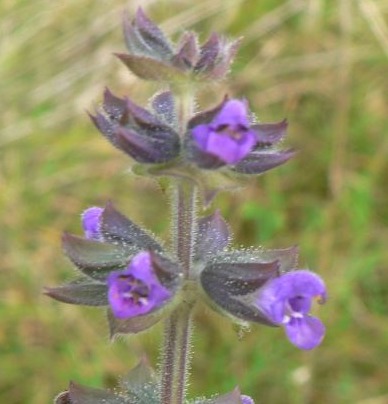
We went on to look at
the Westbourne Open Space at the top of
Westbourne Avenue. As usual, this wayside was full of
swaying grasses, mostly Meadow Foxtail, but we also
saw a fine tuft of flowering Tall Fescue and my
first Yorkshire Fog of the year.
Tall
Fescue is a tall grass with panicles hanging over. It
grows in tight tufts
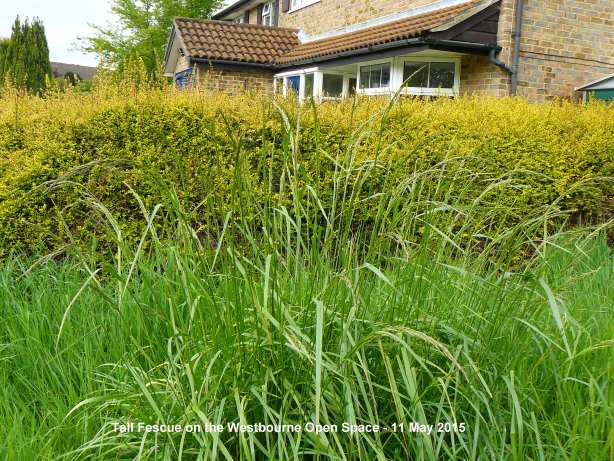
Finally, we had a look
at the wayside at the junction of New Brighton Road
and Horndean Road. We were surprised to see how
Stone Parsley has spread. When we first started
surveying this site Stone Parsley was confined to the
back of the wayside near the hedge, but now it appears
to be widespread. There was a large clump of flowering
Bulbous Buttercups with Red Valerian and
Germander Speedwell nearby making a nice colour
contrast.
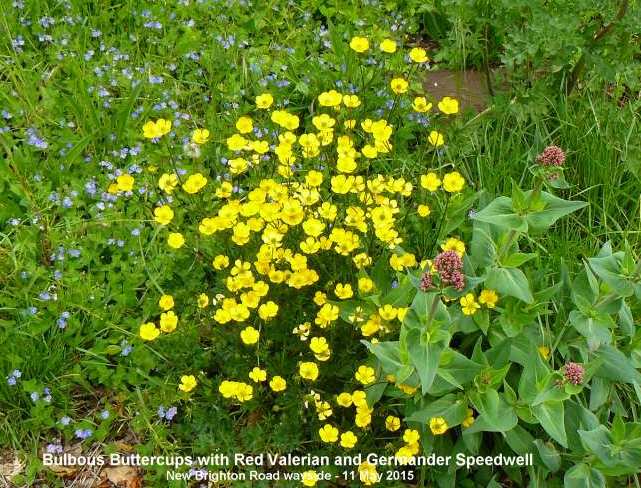
Finally, I had a walk
through the Bridge Road Wayside. Plants of
interest included, Pellitory-of-the-wall near the
grill at St James Road, Hemlock Water-dropwort in
flower, False Fox Sedge in front of the wildlife
conservation area notice, Cuckooflowers now almost
finished, Cut-leaved Crane's-bill, Water Figwort on
edge of stream, Dogwood flowering in central
shrubbery, False Oat-grass, Sweet Vernal Grass, Common
Sorrel.
Sweet
Vernal Grass . . . . . . . . . . . . . . . . . . . . .
. Common Sorrel
Millpond
News
I walked down
to the town millpond at 3pm this afternoon where the
pen swan was on the pond with her 8 cygnets still
intact.
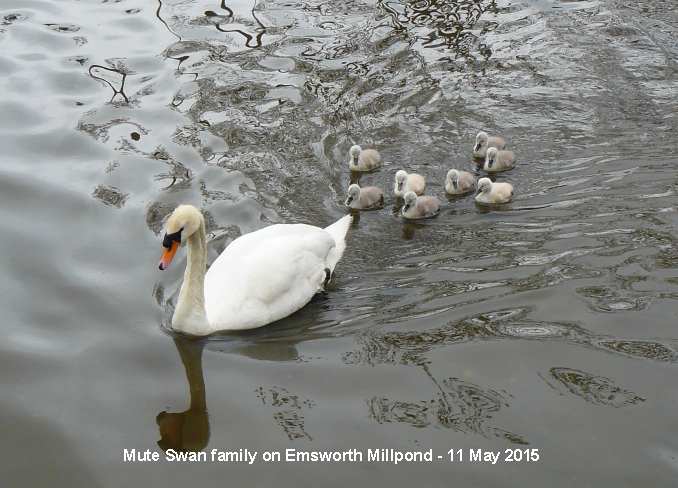
Swifts
Two Swifts
were flying over the houses in Bridge Road at 8pm this
evening. This was my second sighting of them.
SUNDAY
MAY 10 - 2015
Mute
Swan news
All continues
well with the Mute Swan family on the town millpond.
At 12 noon the pen swan was on the nest with most of
her brood snuggled under her wings and just a couple
with heads poking out. The cob was nearby indulging in
a bit of half-hearted nest building behaviour. After a
few minutes the pen got up and led her brood off the
nest and down onto the water watched by a growing and
enraptured audience. They really are compulsive
viewing.
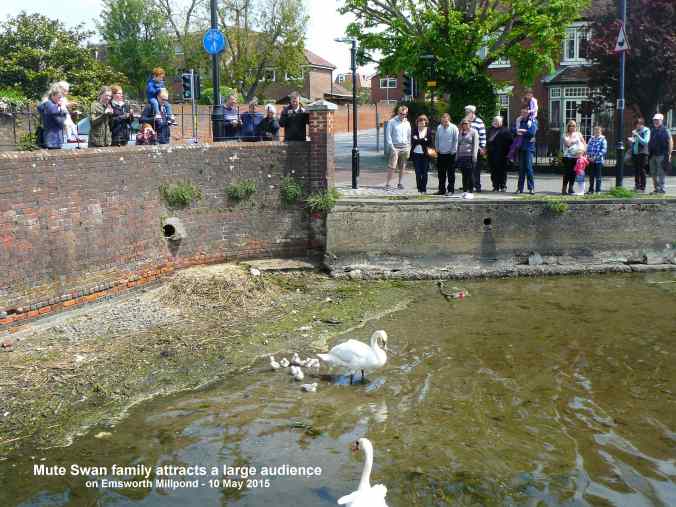
The pen swan then led
her brood of cygnets over to an area of leaf and twig
debris where there was probably a good supply of
insect food which the youngsters appeared to be
sampling, as shown in the photo below. Clearly, they
are already trying to feed themselves. The two pale
(Polish) cygnets still stand out clearly.
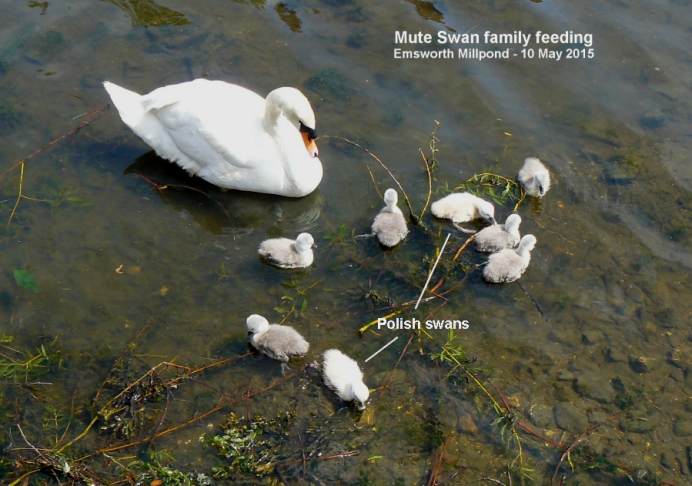
There are two notices
attached to the railings on the bridge suggesting that
people do not feed bread to the swans and to leave
them to their own devices, which is sensible advice.
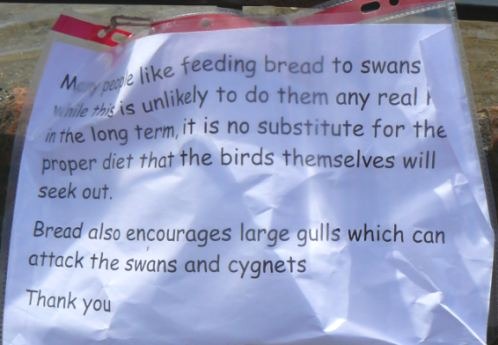
Railway
Wayside
This
afternoon, I had a walk around the wayside to the
north of Emsworth Railway Station to see what new
flowering plants I could find. The yellow flowers of
Bird's-foot Trefoil stood out very clearly.
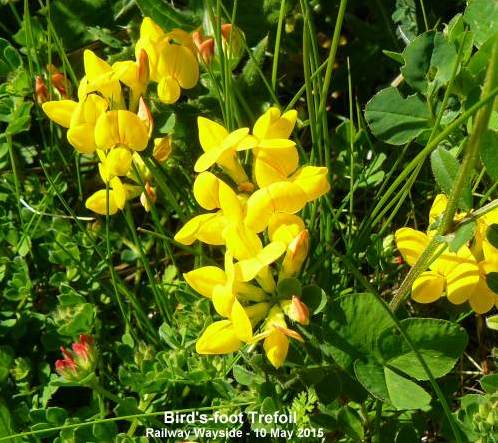
More interesting was a
very good crop of False Fox Sedge, which I have
yet in locate in any quantity on Brook
Meadow.

The area of Marsh
Woundwort at the eastern end of the wayside, which
this wayside is mainly distinguished for, is now
totally covered in a carpet of brambles.
There are a number of newly laid reptile mats on the
site, presumably part of an ecological survey related
to the planned Interbridges industrial development.
Malcolm's
news
Malcolm
Phillips is off to Cuba for 3 weeks and signed off in
great style today with a variety of interesting photos
of wildlife taken on Brook Meadow. Sadly, they did not
include a Water Vole sighting. If Malcolm can't get
one then what hope is there for the rest of us?
Pride of place among his photos must go to a stunning
image of a family of five, possibly six, young
Long-tailed Tits begging for food from their
parent. Brilliant. Wish I had got that one.
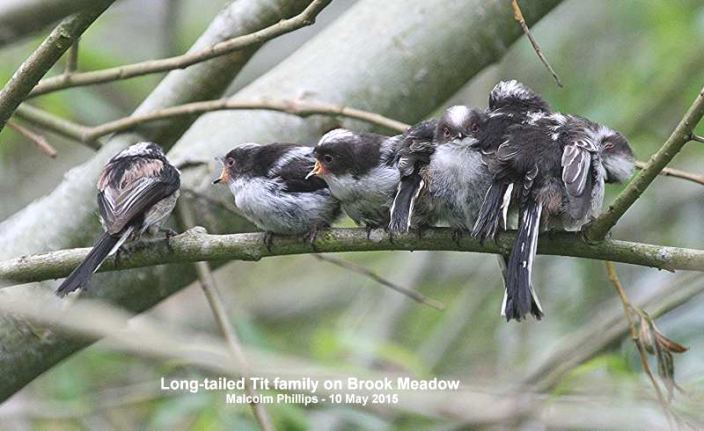
Malcolm also got
several insects, some of which I think I can identify
as they have been seen on Brook Meadow in previous
years. A fairly easy one was this Large Red
Damselfly - the first of the year on Brook Meadow.
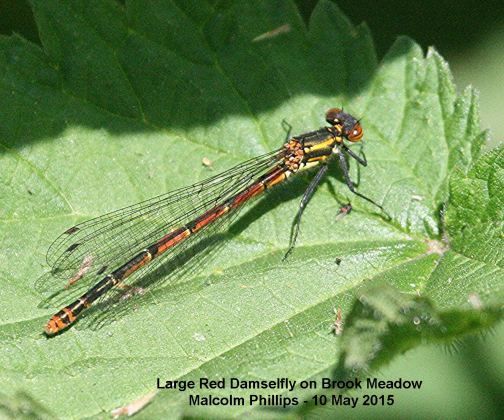
Also fairly easy was a
brightly coloured Froghopper (Cercopsis
vulnerata) which is the fellow responsible for
the mass of froth on plants. The Froghopper is often
called a cuckoo-spit insect as it was thought at one
time in the past that the froth was produced by a
Cuckoo.
Malcolm also got a Red-headed Cardinal Beetle
(Pyrochroa serraticornis). The rather
feathery antennae and all red body and head
distinguishes it from other Cardinals.
But I am not at all
sure what is going on in the following photo of what
seems to be two flies joined together, possibly
mating. I have had a look through Chinery's 'Collins
Guide to Insects' and found one that resembles the fly
in the photo - called Platystoma
seminationis. It is basically black with white
spots on its abdomen. Chinery says it has been seen
sucking dead insects which might be what is happening
in Malcolm's photo.
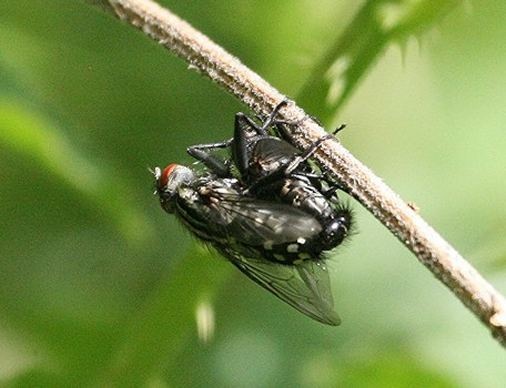
Ralph Hollins thinks
it is more likely to be a Flesh Fly (Sarcophage
carnaria) as the fly has the 'white spots' not on the
abdomen but on the wings, and also it does not have
the longitudinal stripes on its thorax. It is called a
Signal Fly because it is continually 'shivering' its
wings.
Tony Davis says It certainly isn't Platystoma as that
has patterned wings. It does bear a resemblance to
Sarcophaga carnaria but this is a very difficult
family and really cannot be done from
photographs.
|
Cockchafer
Chris Oakley
spotted this easy to identify Cockchafer
beneath one of his window sills, but it seems
to have lost one of its antennae. These
insects are often referred to as May-bugs
since they are very common at this time of
the year, often coming into the house or
crashing into lighted windows. They look a
bit fearsome, but are quite harmless.
|
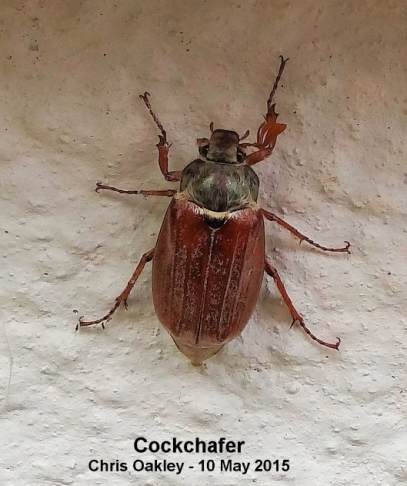
|
SATURDAY
MAY 9 - 2015
Mute
Swan news
There was one
place for me to head for today and that was the town
millpond where yesterday the Mute Swan pair hatched an
astonishing 8 cygnets in the nest by the bridge. I
made my first visit at about 11am, but the weather was
chilly and the pen swan was on the nest with her wings
covering all 8 of the youngsters. However, I returned
in warmer conditions at about 2.30 this afternoon to
find the mother off the nest and swimming around with
her 8 youngsters in the shallow waters of the
millpond. I have only seen one other Mute Swan brood
to equal this one; the pair that nested on Peter Pond
in 2013 hatched 8 cygnets. The most I have ever seen
is a family of 10 cygnets at Hunston near Chichester
several years ago.

The family was watched
by a enraptured audience from the Bath Road
side.
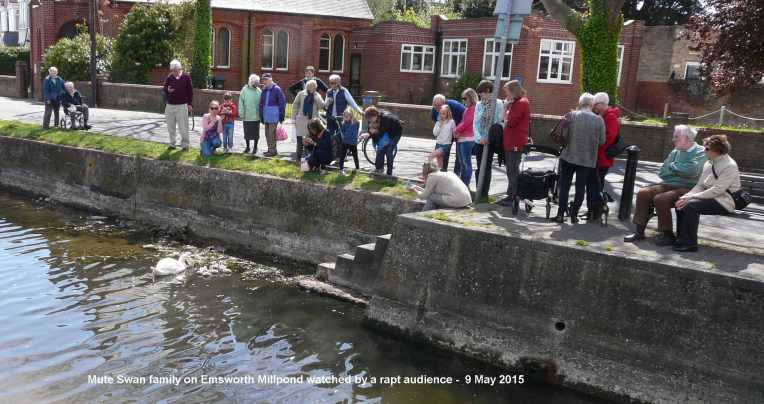
The cob swan arrived
and it was good to see the whole family swimming down
the pond.

I am grateful to
Thomas Irons for alerting me to the fact that two of
the cygnets are distinctly paler than the others.
These can be seen closest to the pen swan in the above
photo. The other 6 cygnets have the regular grey
plumage.
These two pale cygnets could be what is called
'Polish', although it is early days and we must wait
to see how they develop. Interestingly, neither of the
parents are Polish, ie, they both have the standard
black legs and feet. However, there has been a history
of Polish swans in Emsworth so it is not unlikely that
one of the parents might have some 'Polish blood' in
their ancestry. The pen of the pair that has nested on
Slipper Millpond for the past few years was a Polish
swan with pink legs and feet, though she has gone
missing, presumed dead, and the cob remains on its
own.
More
information on the Polish Swans
The Polish
Swan is a 'pure white' version of a standard Mute Swan
and is not a different species. Its legs and feet are
a pinkish-grey colour instead of the usual black. A
pigment deficiency of a gene in the sex chromosomes is
what causes the whiteness in the plumage. When a
female Mute Swan inherits only one melanin-deficient
chromosome she will be a Polish swan, whereas the male
of the same parents will be normal. If the next
generation is produced by two of their offspring the
brood will contain numbers of both Polish and normal
cygnets of either sex.
Polish swans were given their name when they were
imported from the Polish coast on the Baltic sea into
London around about 1800. They were mistakenly thought
to be a new species and were given the name
'Cygnus immutabilis' (ie Changeless
Swan). Polish swans have white down as cygnets and
hence do not change colour from brown to white like
regular cygnets as they reach maturity. See . . .
http://www.theswansanctuary.org.uk/swan_species.php#BM_1
PS I have been a bit inundated with cygnet photos
today and I have to apologise for not including many.
Here is one I have picked out from Charlie Annalls
showing mum leading the way.

PPS - For yet another
cygnet photo (from Langstone Mill Pond this time) see
Peter Milinets-Raby's report below.
Wild
flowers
I spent the
rest of the afternoon mainly looking for anything new
in the way of wild flowers and grasses.
There is an area of verge at the eastern end of the
path behind Lillywhite's Garage which has been missed
(or left) by the council mowers and, as a result, it
has a very nice collection of grasses and flowers,
including Meadow Buttercup, Yarrow and some Red
Clover which looks almost orchid-like in the long
grasses.
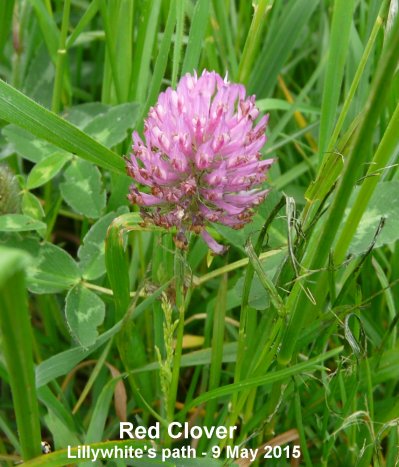
The grasses in this
little patch include Cocksfoot, False Oat-grass, Soft
Brome and Rough Meadow-grass.
Rough Meadow-grass can readily be distinguished
from Smooth Meadow-grass by its long ligules where the
leaves meet to stem - as shown in the following photo.
Smooth Meadow-grass has short ligules.
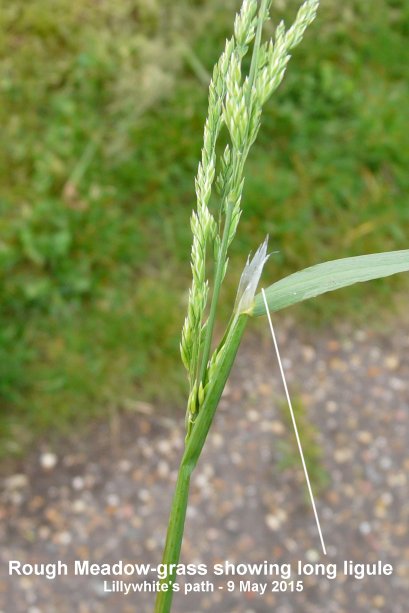
Further round the corner
closer to the garage one finds Common Mouse-ear,
Common Field Speedwell, White Campion and Dove's-foot
Cranesbill. Hedge Mustard is now out on the south bank
of Peter Pond along with Beaked Hawk's-beard and lots
of Common Vetch. Pellitory-of-the-wall is
flowering on the pond side of Hermitage Bridge.
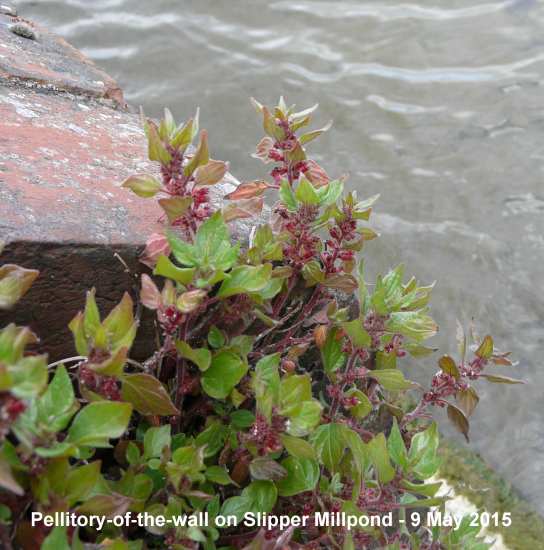
Walking back through
Palmer's Road Copse, I noticed that the prominent tuft
of Remote Sedge is just starting to flower.
This can be seen easily just a little way along the
path through the copse from the south bridge. This is
the only spot on the Brook Meadow site where this
woodland sedge reliably grows.
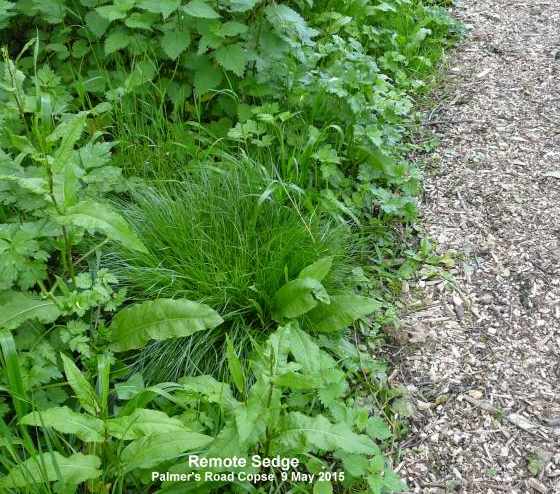
Malcolm Phillips also got a couple of new flowers
today. First, Yellow Flag is now in flower on
the Lumley pond north of the small footbridge.
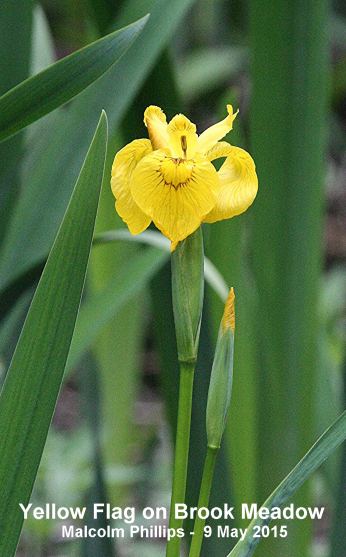
Malcolm also got this nice shot of Horse Chestnut
flowers on Brook Meadow.
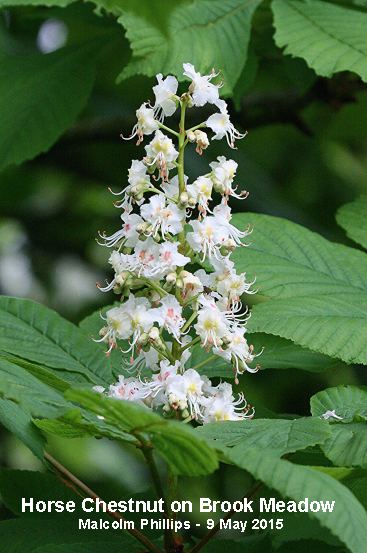
Warblington
shore
Peter
Milinets-Raby popped down to the Warblington shore
this morning (6:45am to 8:45am - low tide -still a
chilly strong wind).
Ibis Field: 1 Moorhen, 1 Little Egret, 1 Swallow, 1
Stock Dove.
Hedgerow behind Conigar Point: Reed Warbler heard - 60
metres away from reed bed.
Mini reed bed: Reed Warbler heard x2, Cetti's Warbler
heard.
Conigar Point: 4 Shelduck.
Pook Lane: 7 Common Tern, 7 Shelduck, 2 Linnets, 1 Med
Gull, 2 Whimbrel, 2 Greenshank, 2 Red Breasted
Merganser.
Langstone Mill Pond: Mute Swan pair with 7 cygnets -
spent most of the morning in the pond outflow stream,
then walked back across the mud to return to the pond
and hid in the channel between the reed bed.
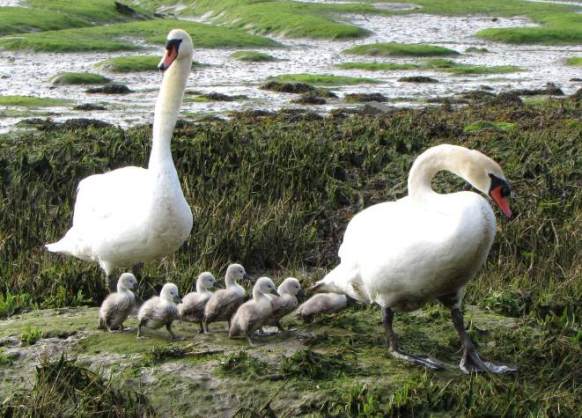
Reed Warbler heard x4.
Cetti's Warbler heard. Gadwall male. Coot pair with 5
tiny chicks.
Grey Heron colony - Sixth nest had two very tiny chick
in it! Here is one larger Heron chick.
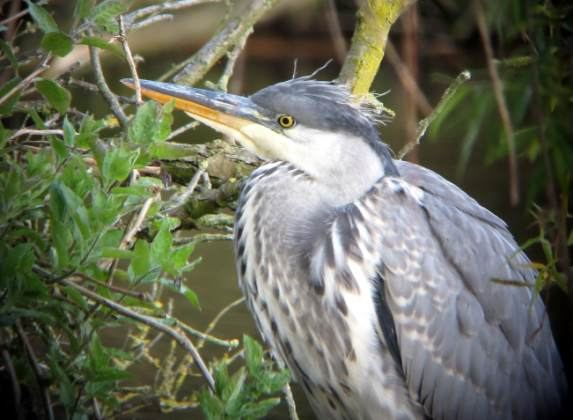
Havant
Water Vole
Christopher
Evans spotted a Water Vole partly hidden in the water
cress bed on the eastern side of Park Road South,
opposite the junction with Solent Road. It did briefly
appear out in the open but moved too quickly for him
to get a decent shot. But, I like the one he got. I
just wish they were as easy as this on Brook Meadow
where we have had no sightings for ages!
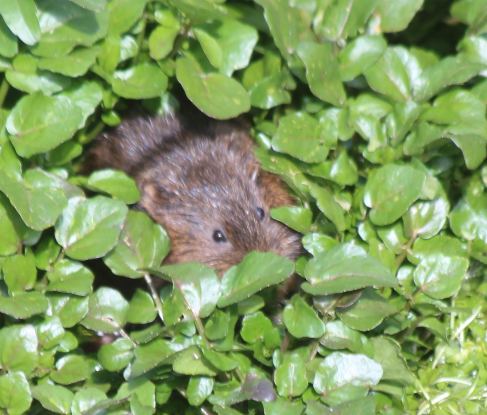
Stansted
Forest
Chris Cope
reported on this morning's walk by the Havant Wildlife
Group
See the report at . . . http://familyfellows.com/hwg-index.htm
FRIDAY
MAY 8 - 2015
Emsworth
Millpond
I had a walk
around the local area this morning, starting with the
town millpond at 10am. The pen swan was snug on the
nest with her wings well spread, covering 7 or
possibly 8 cygnets, of which just two were visible at
the time.
Charlie Annalls was there later when the swans were
changing over and got the following photo of the
cygnets. Charlie said there were definitely 8 cygnets,
she counted them several times!

Slipper
Millpond
I had a quick
look at Slipper Millpond where a Great Black-backed
Gull was on the nest on the centre raft. A male Tufted
Duck was on the pond, which is the first I have seen
there this year. The Coots are definitely back in the
nest box on the north raft for a second try. Their
first brood of 6 chicks were all taken by the gulls.
Peter
Pond
The Mute Swan
cob which has lost its mate was on the east side
embankment of Peter Pond. A local lady told me that
she had seen the lone swan displaying with another
swan, so maybe it will not be lonely for much longer.
In fact, there was a single swan on Slipper Millpond,
so maybe that is the cob's prospective mate?
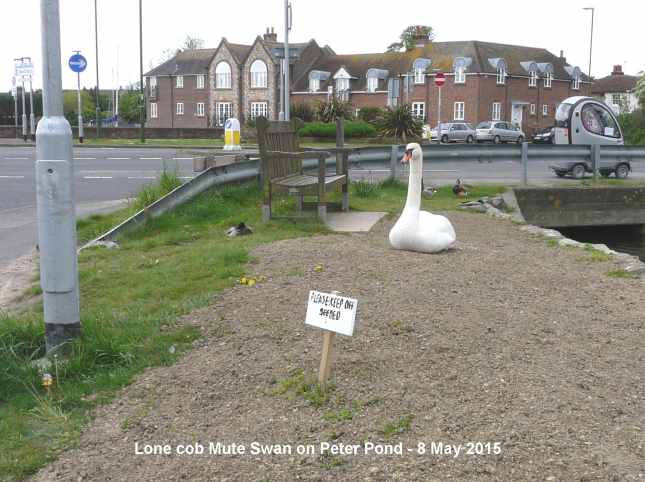
As can be seen in the
photo, part of the east side embankment has recently
been seeded, presumably by the council. It will be
interesting to see what comes up. This is the
embankment that was built up to prevent flooding of
the road at high tides. Both Red and Tall Fescue
grasses are out further north along the east side
embankment.
Wood
Melick
Walking up
Lumley Road towards the entrance to Brook Meadow, I
found a good growth of Wood Melick on the side of the
road immediately opposite the junction with The
Rookery. This attractive grass has a very loose
spreading panicle of tiny spikelets and regularly
comes up on this verge at this time of the year. It
could be natural growth as it is on the edge of a
small woodland, though my suspicion is that it is an
escape from a local garden. This is the first time I
have managed to get a reasonable photo of it.
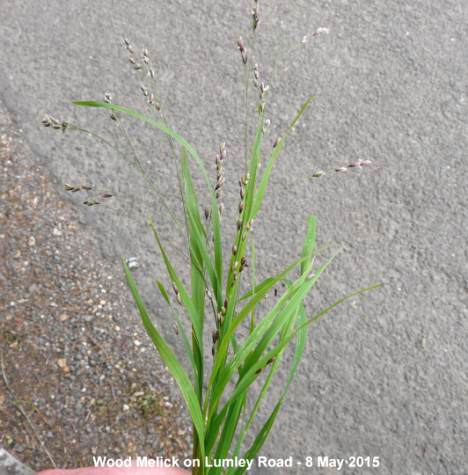
Brook
Meadow
Into the
meadow I was relieved to see Divided Sedge is
now flourishing all over the Lumley area which is the
wet area to the right of the Lumley gate. I had been
concerned as it was later than usual, but no worries.
Distant Sedge is also widespread on the Lumley
area but there is little sign of False Fox Sedge or
Ragged Robin as yet. Both Meadow and Creeping
Buttercup are flowering well.
The non-fertile stems of Field Horsetail are
coming up mainly on the orchid area. Field Horsetail
has two stages of growth; in spring it has brown stems
with cones, then in summer it produces sterile green
stems with vertical ridges without cones.
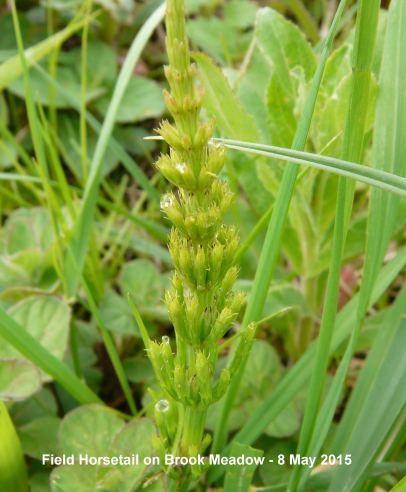
Cetti's Warbler
was singing near the Lumley gate. I heard two
Whitethroats singing on Brook Meadow for the time
this year, the regular one on the causeway and the
other one north of the Lumley copse.
Goat
Willow
The female
catkins are showing up well on the Goat Willow
near the Lumley gate.
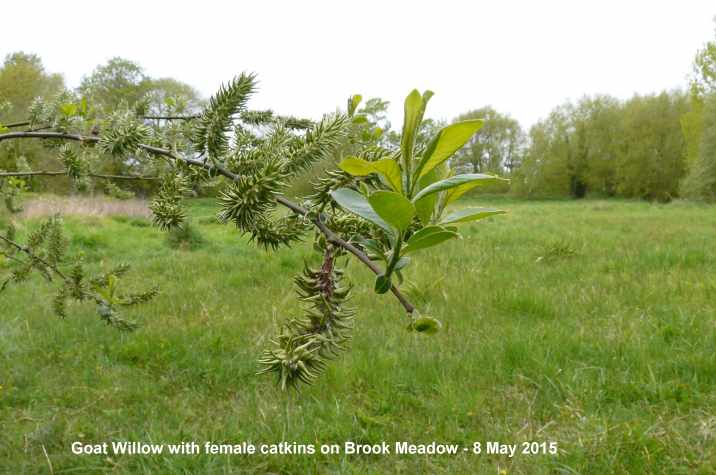
In fact, we have 6
Goat Willows on Brook Meadow which are all female and
6 Grey Willows which are all male, having yellow
catkins in the spring. A reliable way to distinguish
between Goat and Grey Willow before the flowers arrive
is by peeling back a little of the bark on a twig; the
wood beneath the bark is smooth on Goat Willow and
ridged on Grey Willow.
The orchid area is currently peppered with tall
Meadow Buttercups and the leaves of Yellow
Rattle are showing everywhere. Two new plants in
flower were Common Mouse-ear and Common
Vetch.
The tall Aspen tree which was donated by
members of the Haskins family and planted on the
eastern side of Brook Meadow on 22 Dec 2005, is
probably the only tree on Brook Meadow that has yet to
develop its leaves. I had a look at the leaf buds and
they look fine and are clearly not far from sprouting.
Is Aspen the latest of trees to leaf?
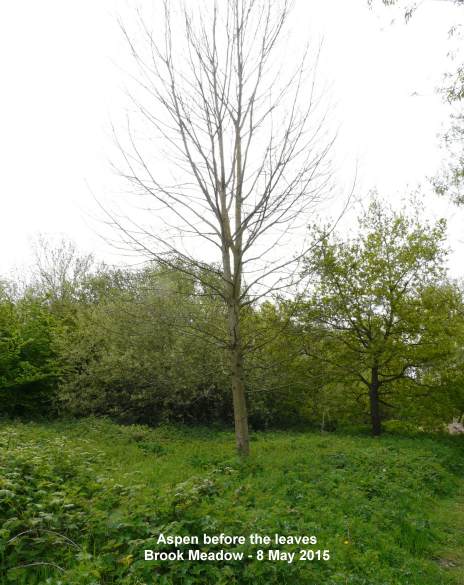
Mystery
'Ladybird'
Finally, I
came across this unusual 'Ladybird' crawling around in
the low vegetation that I did not recognise. Maybe it
is not a Ladybird at all. Can anyone help?
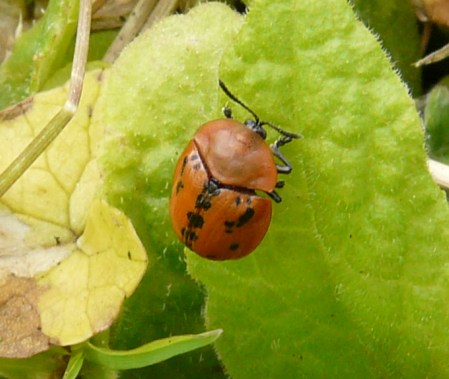
Hollybank
Woods
Ralph Hollins
went over to Hollybank Woods yesterday to have a look
at the Early Purple Orchids on Longcopse Hill
which he says are now at their peak. Ralph counted
397, which though good, is well below the numbers that
have been there in previous years. Ralph also had a
look at the wild Lily of the Valley plants
which are now in full flower in the Jubilee Plantation
area. See his wildlife diary for full details.
http://ralph-hollins.net/Diary.htm
Moorhen
family
Tony Wootton
was at Arundel Wildfowl and Wetlands Trust today and
got this cracking shot of a Moorhen with two young
chicks.
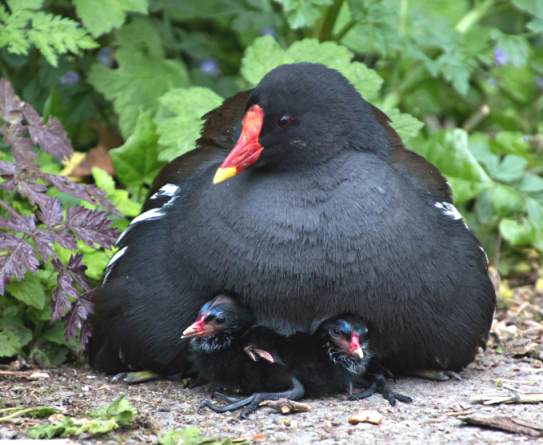
THURSDAY
MAY 7 - 2015
First
Swifts
As I
replenished the bird feeding station this morning, I
happened to glance up and was delighted to see two
Swifts wheeling around in the sky over the Bridge Road
houses. This was exactly the same date (May 7) that I
saw the first ones last year. Here is a photo I took
of one over our house last year.
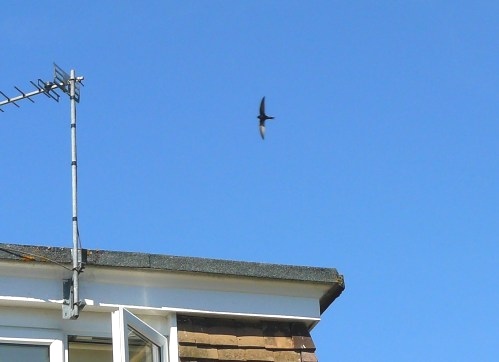
As far as I am aware
these were the first local Swifts of the year. Large
numbers of Swifts have been seen at Pulborough Brooks
and at Rye Harbour in the past week. Closer to home,
six Swifts were seen screaming and circling over Elm
Grove, Southsea at 9am this morning - reported on the
HOS Bird sightings.
Squirrel
family
As I was
watching the Swifts circling overhead, my eye caught a
movement in the corner of my next door neighbour's
roof. Three pairs of little eyes were peering at me
from a gap in the roof beneath the eaves. It was a
family Grey Squirrels - a mother and three youngsters.
I got my camera and took some shots as the squirrels
skipped around on the roof.
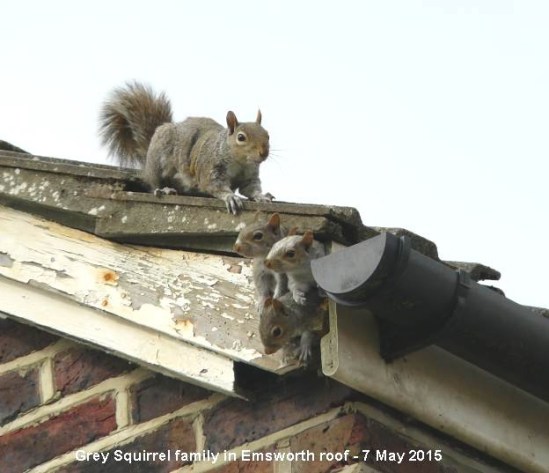
I do hope this does
not prompt the hole being covered up as this hole has
quite a history. Many years ago I used to see
Starlings nesting in the hole and I have suspected
Swifts have also nested there. In June 2013 Tree
Bumblebees made a nest there, but never squirrels.
I read that the average litter size is three and that
the male Grey Squirrel takes no part in the rearing of
the youngsters, which is entirely done by the female.
The youngsters disperse when their teeth are fully
grown and they can feed themselves, usually at about
10 weeks old. So, I assume they will be around for a
little while longer.
Swan
cygnets
Early this
morning Jennifer Rye e-mailed me to say she had seen
two cygnets in the reed nest on the town millpond at
about 9am. So, hatching is underway, some 3 days
earlier than I predicted. I checked the nest site a
couple of times later in the day and by 3pm six
cygnets were in the nest with two eggs remaining, one
of which was definitely hatching.

Along with many other
people I watched the two swans swap over the brooding
duties as the chick in the 7th egg started to break
through its shell. What a marvellous experience it was
for me and others watching to be able to see new
wildlife coming into existence at such close quarters.

Great
Black-backed Gulls
I checked the
Great Black-backed Gulls on Slipper Millpond this
afternoon. I caught them just as they were changing
over nesting duties. The female flew off towards the
harbour leaving the male to brood the eggs.
I think the last egg was laid on April 22nd. As
incubation is 27-28 days from the laying of the last
egg, my estimate for hatching is about Wednesday 20th
May, so we have another couple of weeks to wait.
Red
Fescue
On the
footpath to the west of Slipper Millpond I found the
grass Red Fescue was just starting to emerge. This
grass is fairly easy to identify from the tight
panicle and the single leaf jutting out from the stem
at an angle of around 45 degrees which is nicely shown
in the following photo.

Other
news
Malcolm
Phillips did not have long on Brook Meadow today, but
managed to capture a superb photo of this Small
Tortoiseshell.
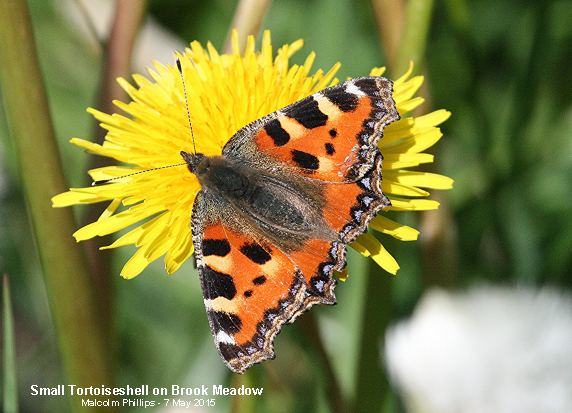
WEDNESDAY
MAY 6 - 2015
Baffins
Pond
I had to go
into Portsmouth this morning, so this gave me the
chance to have a walk around Baffins Pond, one of my
old haunting grounds in the early days of my
birdwatching. The pond and its environs have changed
dramatically since I used to visit in the 1990s when
there has barely anything in the way of natural
vegetation around the pond. Now, the place is
transformed by the planting of wetland areas and it
looks just great - and is great for wildlife too!
Greater
Tussock Sedge
Several marshy
type plants were flowering on the wetland areas of
Baffins Pond including Yellow Flag and Marsh-marigold.
But I was most interested to see a good growth of
Greater Tussock Sedge which I had not seen here
before, though I am sure it has been here. This is a
tall sedge with rough triangular stems with sharp
edges, ie fulfilling the adage that 'sedges have
edges'. Its most distinctive feature is the large
inflorescence at the top of the stems containing many
spikelets.

It reminds me of False
Fox Sedge, which we get on Brook Meadow, but with a
much bigger inflorescence. Greater Tussock Sedge is
not a common plant in our local area and the only
other place I have seen it growing is on the edge of
Fishbourne Millpond.
It is not recorded in SU70 in the 'The Flora of
Hampshire' though that was published before the
wetland areas were developed at Baffins Pond. It
probably would not count anyway as it was almost
certainly planted when the wetlands were set up.
Canada
and Barnacle Geese
I was
interested to find a Canada Goose on the edge of the
pond with a couple of Barnacle Geese. This is not a
standard Canada Goose and Eric Eddles has had it
identified as a Canada-Barnacle hybrid (see
blog entry for Feb 15th); one can see the Barnacle
influence in the extra area of dark on the chest.
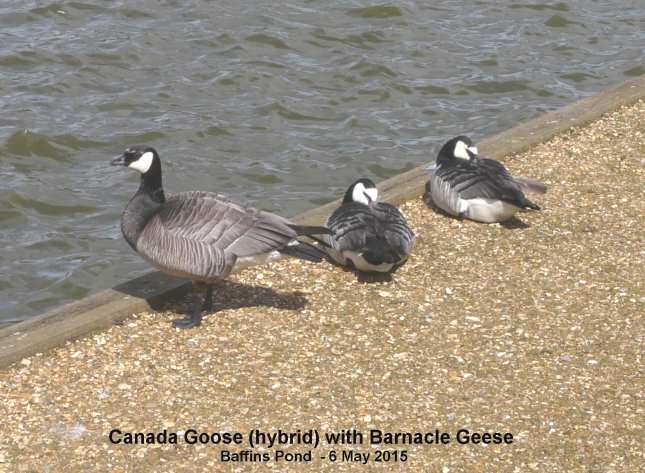
The two Barnacle
Geese must be the those remaining from the
original brood of five goslings reported on this blog
by Eric Eddles on June 6th, 2014. I assume they came
from pure Barnacle Geese and not from a union with a
Canada Goose.
Barnacle Geese are attractive feral geese and do not
migrate like their wild counterparts. They were a
common feature of Baffins Pond in 1990s and early
2000s when I used to do my weekly surveys. They
reached a peak of 42 in the winter of 1998-99 and used
to migrate regularly to Titchfield Haven where they
were affectionately known as the "Baffins Gang".
However, numbers gradually fell away, though I believe
a pair did produce a brood of 5 on the pond in 2008.
Nowadays, I only make occasional visits to the pond,
though Eric Eddles keeps a good eye on the place as he
lives locally.
Fort
Purbrook
On the way
back home I called in to Fort Purbrook mainly to check
on the Upright Brome grass that I thought I
might also have found at the Warblington Cemetery
yesterday. I found lots of Upright Brome on the side
of the track leading to the fort which was clearly
quite different from the Warblington grass with
thinner spikelets. I think the grass at Warblington
Cemetery was probably Soft Brome. Here are the two
grasses for comparison.

It was not the best
day to go onto Portsdown Hill with the gale force
winds blowing in from the sea, so I did not stay long.
However, I did stay long enough to see and enjoy the
first of the many splendours this area has to offer in
the way of wild flowers and grasses.
Cowslips were
resplendent in front of the fort.

Also, lots of
Crosswort.

There was also some
Milkwort flowering alongside Glaucous Sedge
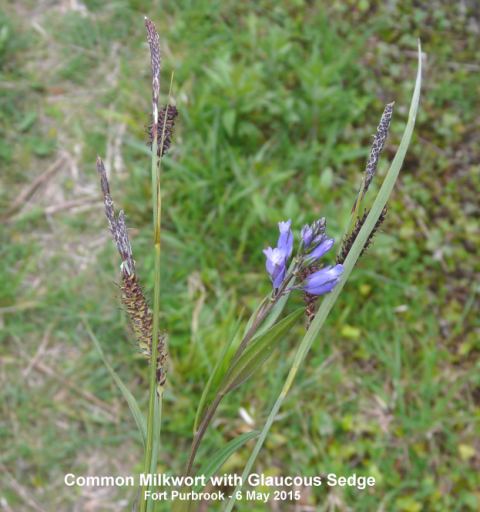
I also spotted the
first flowers of Bird's-foot Trefoil just starting to
open.
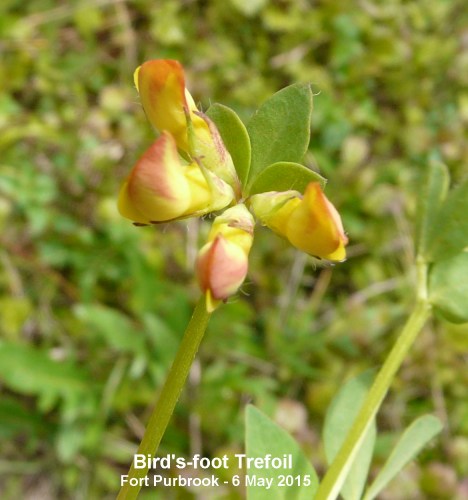
Hoverfly
Malcolm
Phillips spent a very windy hour on the meadow this
afternoon. He did not get much for his efforts apart
from this rather nice hoverfly which I think is the
very common Syrphus ribelsii.
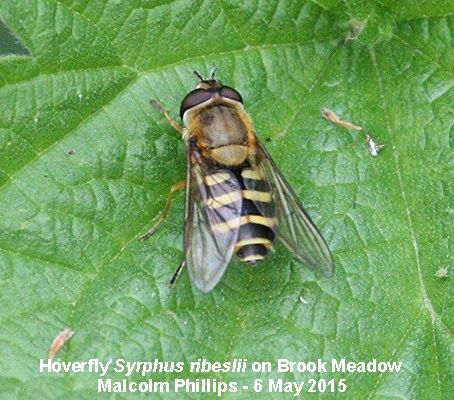
Mystery
fly identified
Tony Davis
confirmed the identification of the fly photographed
by Malcolm Phillips on Brook Meadow yesterday as
Phasia hemiptera. I gave the old name
Alophora hemiptera which is how it was
described in my copy of Chinery's 'Collins Guide to
Insects'. Maybe, I should invest in the new edition?
Tony says there are no other species which look like
this fly so the identification is sound.
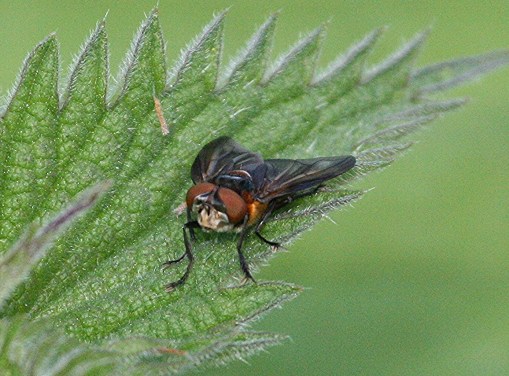
Phasia hemiptera
is a tachinid fly found throughout Northern and
Southern Europe. It is a strongly sexually dimorphic
species, males being more colourful with curved
patterned wings. Like most tachinid flies, the female
lays her eggs on other insects, the larvae then
develop inside the living host, devouring it and
eventually killing it.
Swan
with eggs
John Neal got
a nice photo of the Mute Swan tending to her eggs on
the nest on the town millpond yesterday.
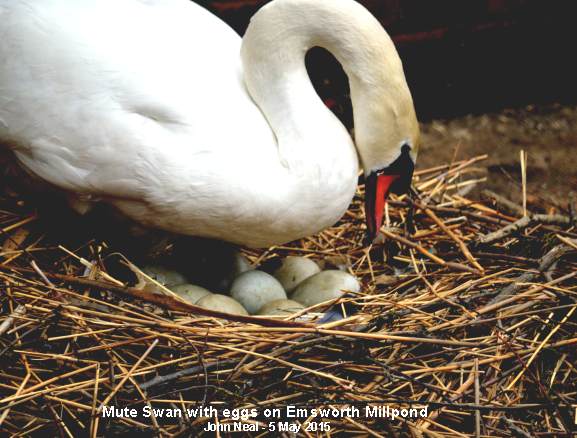
Mallard
mating behaviour
The Irons
family had an unpleasant experience when they found a
dead female Mallard near the swan nest with two male
Mallards trying extremely hard to mate with it. They
asked if this is usual behaviour? And as it was right
next to the nesting swan, could it have been attacked?
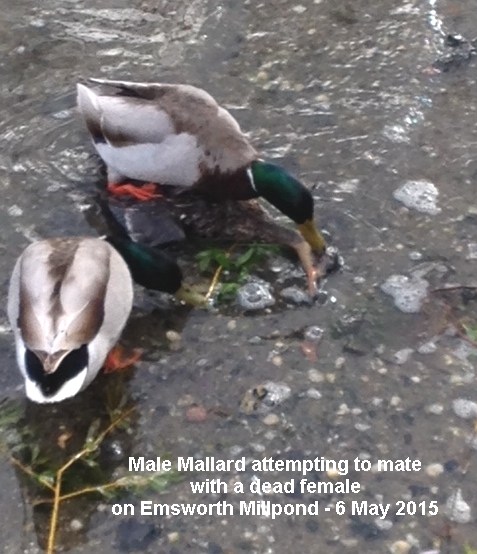
Personally I have
certainly never witnessed this type of behaviour,
though I have often seen several male Mallards trying
to mate with a female, almost drowning her in the
process. My guess is that this is what happened in
this case and that the Irons just caught the end of
the event.
TUESDAY
MAY 5 - 2015
Warblington
Cemetery
I had to take
Jean and a neighbour over to Warblington Church for a
funeral this afternoon, so I took the opportunity to
have a look at the natural burial area of the
Warblington Cemetery extension. There is a useful
information board on the site with Ralph Hollins's
wild flower sightings and photos along with John
Goodspeed's Nature Notes. Ralph Hollins has a
Cemeteries page on his web site which is worth
consulting.
I did not find the Cowslips or the Snake's Head
Fritillaries that were on Ralph's list, though his
last update was on April 9th. However, I did find a
couple of very interesting grasses. They were both
very hairy and almost certainly Bromes. I decided the
one with stems bearing loose panicles with drooping
branches was Hairy Brome. The more upright one
looked like Upright Brome though I usually
associate this grass with the chalk downland of
Portsdown Hill. I assume both these grasses were
brought in with the seed mixture that is used for the
natural burial area.
Emsworth
grasses
I went for a
walk around Emsworth and found a number of other
grasses which had come out over the past few days. On
Brook Meadow, I found Rough Meadow-grass
starting to open in Palmer's Road Copse and on the
main river path. False Oat-grass was also
coming out on the main river path.
Down by the Hermitage Millponds, Wall Barley,
Cocksfoot and Soft Brome were out on the
grass verge at the eastern end of the Lillywhite's
path and Red Fescue on the south bank of Peter
Pond by the main road. The best way of identifying Red
Fescue is to look for the single leaf sticking out
from the stem at a sharp angle.
I also found my first Germander Speedwell of
the year by Peter Pond, opposite Gooseberry Cottage.
This is the speedwell with two lines of hairs down
either side of the stem. You can probably just see
them on this photo.

Malcolm's
news
Malcolm
Phillips was on Brook Meadow as usual today and saw
the the first flowering Wintercress of the
year. This is a fairly common spring flower which
brings a welcome touch of golden yellow to the meadow.
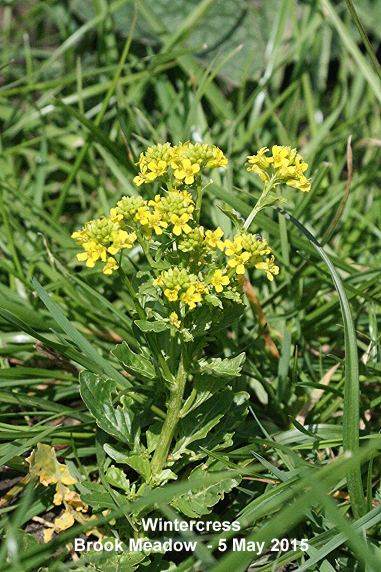
He got this excellent
photo of a 'Nursery-web spider' (Pisaura
mirabilis) - resting in typical fashion with its four
front legs outstretched.
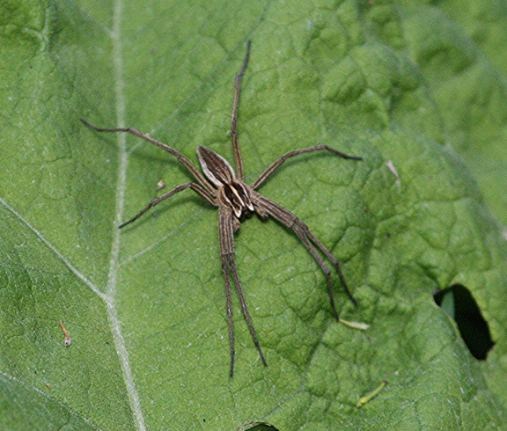
Finally, Malcolm got a
photo of this small fly. My very tentative guess is
one of the family Tachindae, possibly Alophora
hemiptera (Chinery p.212). Any other ideas
welcome.

MONDAY
MAY 4 - 2015
Swan
nesting news
The Mute Swans
on the town millpond were in the process of changing
over nesting duties when Jean and I passed by this
morning. The photo shows the cob engaged a bit of
tidying up of the nest while the pen gets herself
ready to settle down on the eggs for the rest of the
day. I could not actually see the eggs in the nest,
but I assume they were covered which is an extra level
of sophistication that I had not observed before with
this pair. Covering helps to keep the eggs warm and
safe. Predicted hatching date is Sunday May 10th,
though I cannot be really sure as I did not have the
date the last egg was laid.

Pike
in river
The Irons
family was on Brook Meadow today where they got some
nice photos of butterflies including Peacock and
Comma. Most interesting they spotted one of the
Pike that inhabit the river and young Thomas
managed to get a very good photo of it from the south
bridge. Pike are prime river predators and could
seriously harm our already fragile Water Vole
population, particularly around breeding time. But
there is nothing we can do about them except hope and
pray.

Mallard
family
The Irons
family then went over to Peter Pond where they found
the Mallard family seriously diminished in number.
From 14 ducklings on April 26 the family was down to 6
on May 1st and is now down to just 4. Young ducklings
have many predators ranging from Pike to Grey Heron
and Herring Gull.
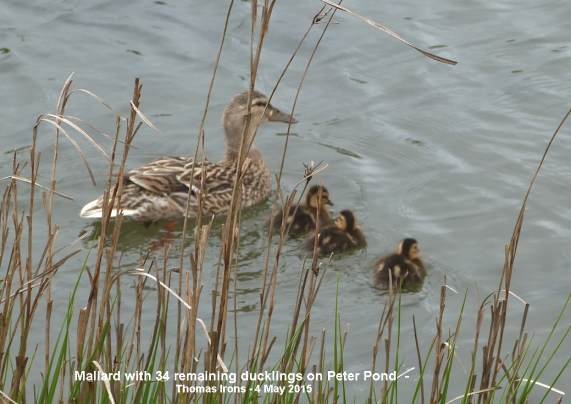
Small
Copper
Malcolm
Phillips had a good day on Brook Meadow, where he got
the first Small Copper of the year plus a couple of
Holly Blues. Small Copper overwinters as a
caterpillar, then pupates into a chrysalis in early
April before finally emerging as an adult butterfly in
early May. They are usually only seen in ones or twos.
Larger numbers emerge in the second brood in August
and after warm summers there might be a third or even
a fourth brood with adults flying well into October.
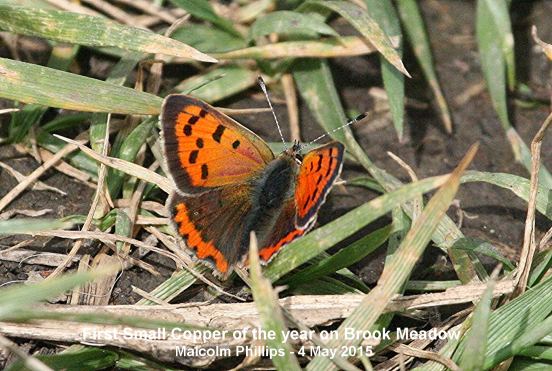
Birds
Malcolm also
got some good shots of the Cetti's Warbler that
seems ever present in the Gooseberry Cottage area and
the Whitethroat which sings constantly from the
trees on the causeway. But there only appears to be
one Whitethroat on the meadow at the moment; usually
we have up to three.
Langstone
Mill Pond
Peter
Milinets-Raby popped down Wade Lane late this morning
at 11:25am for an hour - high tide). Not much to
report.
Wade Lane: Med Gull over, 4 Swallow, Singing
Chiffchaff.
Langstone Mill Pond: There were six male Tufted Ducks
chasing one poor female and a pair of Gadwall.
The female Mute Swan was still firmly on her nest, but
I did notice a young cygnet poking its head out
from under her body. So probably in the process of
hatching. I wonder how many?
Brian's note: Was this the first Mute Swan cygnet of
the year?
3 Reed Warbler heard, Cetti's Warbler Heard.
The Little Egret nest that had its eggs snatched from
was still empty - so abandoned.
Grey Heron colony: Both Holm Oak nests empty. South
nest - two young. Middle nest - two young. Fifth -
adult still sitting. Sixth - adult still sitting.
Off shore: 4 Sandwich Tern.
SUNDAY
MAY 3 - 2015
Brook
Meadow painting
Jean and I
visited Emsworth Museum as part of the Emsworth Arts
Trail today and were delighted to find Marian
Forster's original artwork for the Brook Meadow
interpretation board hanging prominently just inside
the front door.
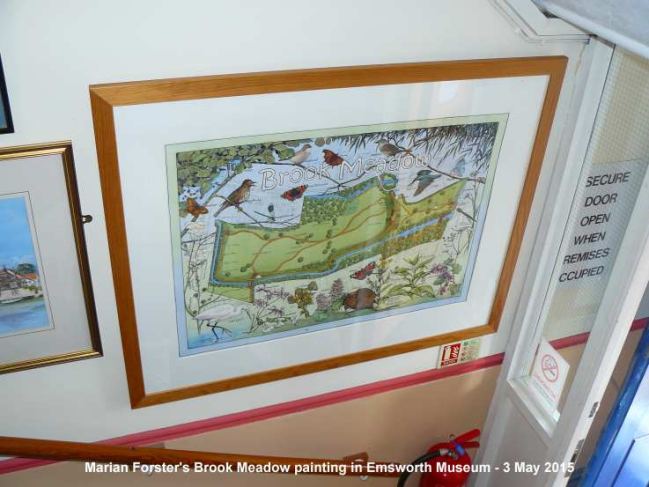
This brilliant
original work by Marion was commissioned by the Brook
Meadow Conservation Group and took Marion over a year
to complete. After the prints were taken for use with
the interpretation boards, the original painting was
donated to the Museum in April 2005 for safe keeping
and looks as good as new. Being able to view the
painting this closely, gives one the opportunity to
fully appreciate the detail and fine artwork that went
into its production.
Wild
Clary
Following his
discovery of the rare Wild Clary in flower on the
grass verge at the northern end of Christopher Way
yesterday, Ralph Hollins comments that the flowers
have benefited from the Council's mowing regime.

He says, "The 'no
mowing' regime of the Christopher Way Wayside has
forced the Wild Clary to abandon its original site (on
the wayside) and move to the nearest site where it has
a chance to survive (i.e. where the grass has been cut
by the council). I have always thought that the
excellent Waysides project can only succeed if the
people who live close to the sites you wish to protect
actively manage them in a way that suits the plants
you wish to conserve (and as with all managed nature
reserves they will encourage certain species to
survive while preventing other species from gaining a
foothold even it factors such as climate change make
the site suitable for their natural growth). I know
this is often a 'no win' situation and is very
disheartening for those who know what should be done
but cannot command the manpower to achieve
it."
Other
news
The long
yellow catkins of the Basford Willows are now
cascading down onto the southern end of Palmer's Road
Car Park as they usually do at this time of the year.
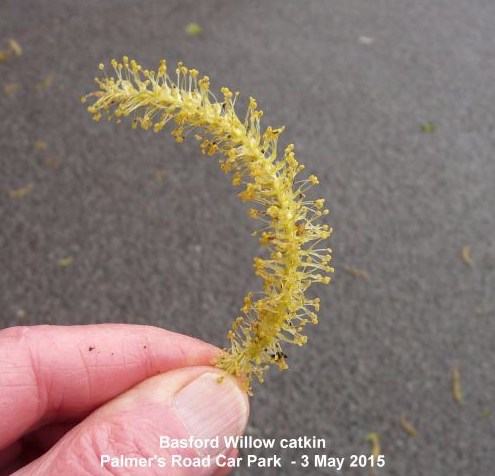
The removal of one of
the large Willows from the edge of Palmer's Road Car
Park has opened up the view into the copse, allowing
one to see more clearly the tall straight trunks of
the Western Balsam Poplars.

SATURDAY
MAY 2 - 2015
Malcolm's
news
Malcolm walked
round Brook Meadow this morning, but did not find much
of interest. So, he stood on the foot bridge at the
top of Peter Pond for about an hour and a half and got
some good birds. Just shows what patience can do.
From
top left to bottom right: female Blackcap, male
Bullfinch, Cetti's Warbler, Greenfinch
Ralph's
news
Ralph Hollins
was in Emsworth today and found the first open flowers
on the Wild Clary on the grass verge at the
northern end of Christopher Way with lots of Shining
Cranesbill in the nearby public path. Wild Clary is a
very rare plant that has been flowering on this
wayside for several years, despite the regular cutting
of the grass by the council workers. Here is a photo
of the flowers taken previously.
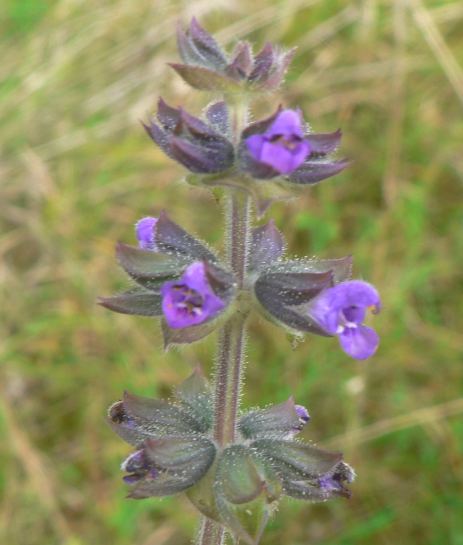
Two botanical
surprises for Ralph were (a) Three-nerved Sandwort
(Moehringia trinervia) flowering in a Warblington Farm
field beside the Selangor Ave path; and (b) was a
bright yellow plant of American Wintercress (Barbarea
verna) on the north side of Warblington Road, two
houses before reaching Clovelly Road.
Less welcome was a large dead Badger beside Southleigh
Road about 200 yards east of the entrance to
Southleigh Farm.
Hampshire
Farm
Chris Oakley
reports that the Shelducks are back on the pond of the
Hampshire Farm open space after missing last year.
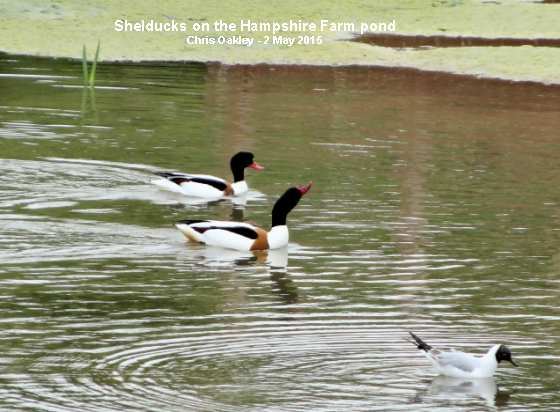
"It appears to be the
same pair that stayed the summer of 2013; the male has
a distinctive white patch above his beak. There were
several Black-headed Gulls and one passing Swallow,
bearing in mind the cold blustery day, that Swallow
was the one that does not make a summer. I found two
new plants for my list Winter Cress and a Thyme-leaved
Speedwell and I found my first Corn Cockle of the
season."
Tony's
news
Tony and
Hilary Wootton had a couple of days away in the week
and took the chance to visit Rye Harbour Wildlife
Trust Reserve. Tony says it was very windy and open,
but they had lovely views, of amongst others, two
Hobbies and a male Marsh Harrier. Here is one of the
Hobbies which Tony managed to capture in flight with
its tail feathers spread out. Note also the streaked
underparts and the black and white hood which are so
characteristic of a Hobby.

FRIDAY
MAY 1 - 2015
Millpond
News
The pen Mute
Swan was snug on her reed nest on the town millpond by
the bridge when I passed by this morning (see photo).
My predicted hatching date is May 10th. Her mate was
patrolling further up the pond at the bottom of Nile
Street. While I was there he was approached by the
second pair of resident swans with wings raised, but
got to within 10 yards of the cob then turned round
and retreated. 'You are going no further' was the
message. (see photo)
The willows on the
east side of the pond along Bridgefoot Path are now
showing their long bright yellow catkins, many of
which are scattered on the ground. I think these trees
might be one of the Goat Willow 'Basford' hybrids.

Hermitage
Millponds
I walked down
Queen Street to Slipper Millpond where both Great
Black-backed Gulls were on the centre raft, one on
the nest and on standing guard on the new framework.
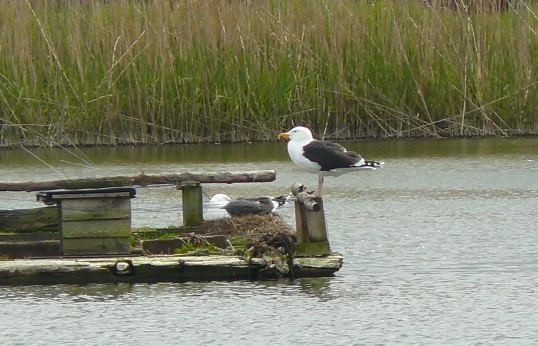
A Mallard with 6
small ducklings was on the east bank of Peter
Pond. This is probably the remains of the family of 14
that was seen here on April 26.
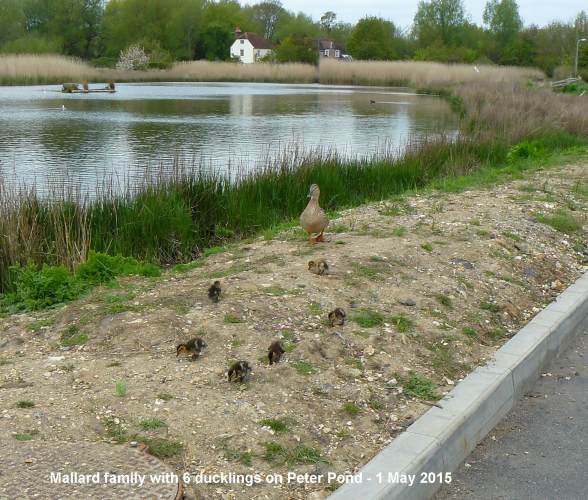
Smooth
Sow-thistle is now in flower on the east bank of
Peter Pond. These plants have attractive dual colour
florets. Note also the leaves which clasp the stem
with pointed auricles which distinguishes it from
Prickly Sow-thistle in which the auricles are rounded.
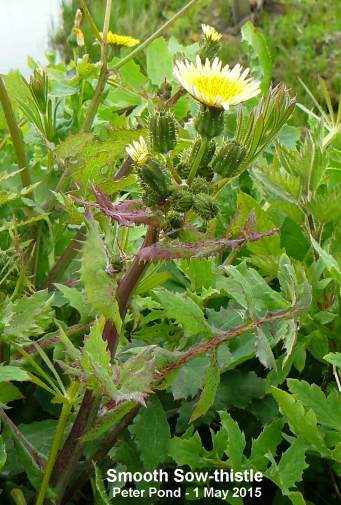
Lumley
Road
From Peter
Pond I walked straight up Lumley Road heading for
Lumley Mill. Along the edge of the road Garlic Mustard
was in full flower plus the first flowers of
Cleavers. These are very tiny white flowers.
Further north along Lumley Road I found my first
Grey Sedge of the year with spikelets just
starting to emerge. This is a good spot to find this
plant.
|
Cleavers
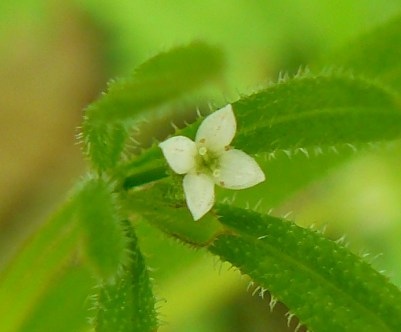
|

|
Just before you get to
Lumley Mill where the footpath branches off left for
Seagull Lane there is a nice flowering of Greater
Periwinkle. This attractive perennial garden plant
flowers here every year. The slightly hairy edges to
the leaves (which can just be seen on the photo)
distinguishes this plant from the less common Lesser
Periwinkle. It was introduced to cultivation from the
Mediterranean by 1597 and first recorded in the wild
by 1650.

Lumley
Mill
I was
surprised to find the large 'Goldfish' still present
in the river by Lumley Mill just north of the bridge.
This was last photographed by Malcolm Phillips on 26
July 2014 and identified by Mike Wells as a Golden
Orfe.
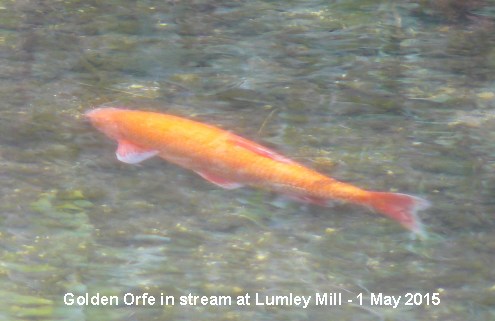
At the start of the
path towards Seagull Lane agaist the tall wooden fence
of Constant Springs are several plants of Greater
Celandine , one of which was flowering well with
its very delicate yellow flowers. This is the only
spot I know of in Emsworth where this plant grows. It
is not related to the more common Lesser Celandine.
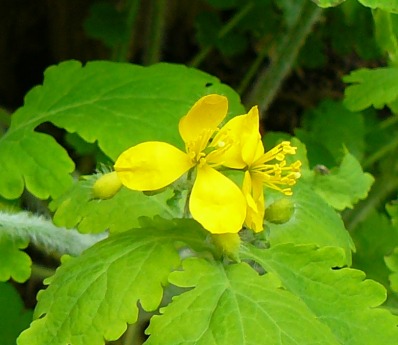
Walking along the path
from Lumley Mill towards Seagull Lane I stopped to
inspect a bright green beetle which was
crawling around on Common Nettle leaves. I thought at
first this might be another Nettle Weevil like what
Chris Oakley found on the Hampshire Farm site - see
yesterday's blog for photos. However, this beetle was
clearly a different shape and not a weevil. My guess
is that it is a type of Leaf Beetle which Chinery says
are often brightly coloured with smooth rounded
outlines (page 282 in my copy of Collins Guide to
Insects).

Waysides News
The northern
entrance to the Dolphin Creek wayside has been cut
since I last visited with the Tree Mallows removed and
the waysides notice gone. The notice has also been
removed from the tree at the other end of the path
which is ominous. However, I was pleased to see the
usual good flowering of Ivy-leaved Toadflax on
the wall of Dolphin House. Ivy-leaved Toadflax is not
a native plant, but was introduced to gardens from S
Europe and first recorded in the wild in 1640. So, it
has been in the wild for a good long time!
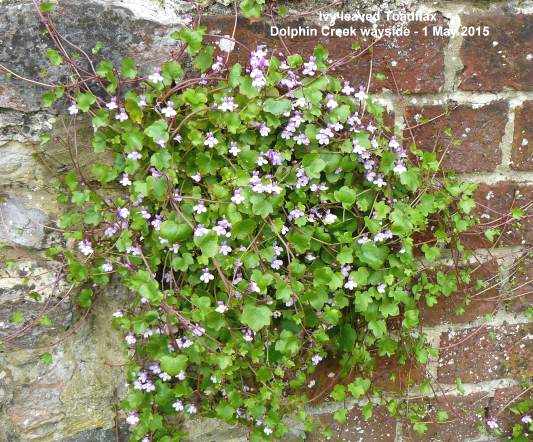
Water
Vole sighting
Frank Naylor
saw a Water Vole at about 7.15 yesterday evening. It
swam across from the reeds below the observation fence
to the sluice gate area. Frank lost sight of it round
the sluice gate bend. This was the 4th sighting we
have had from this specific area in the past week
which suggests all were of the same animal.
Hayling
Billy Line
Mike Wells had
a wander along the Old Hayling Billy Line on Thursday
morning. He got some great photos including this
superb male Kestrel which I could not resist.
Brilliant.
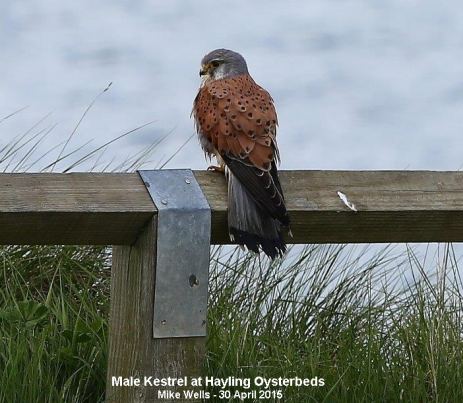
Walking north along
main path Mike also spotted an Adder basking in
the sun, near a cleared area on the right. Sadly, by
the time Mike had adjusted his camera, the snake had
slid away into the undergrowth. But Adders are often
seen along this track, so please keep a look out for
them.
Warblington
shore
Peter
Milinets-Raby was out this morning to walk along the
Warblington shore (6:44am to 8:45am - tide pushing in
- grey and very chilly). A few interesting
sightings:
Ibis Field: Goldcrest singing, Pheasant heard, Adult
summer Med Gull feeding at the feet of the cattle, 2
Blackcaps singing, Chiffchaff singing.
Hedgerow down to Conigar Point: Skylark heard,
Whitethroat singing briefly, Cetti's Warbler Heard,
Reed Warbler heard from mini reed bed, Cuckoo singing
very briefly by mini reed bed.
Conigar Point: Greenshank (G//R+BB//-), 2 Shelduck, a
pair of Red-breasted Merganser, 1 Great Black-backed
Gull.
Pook Lane: 2 Stock Dove, 3 Whimbrel. A pair of
Shelduck were observed in the field south of the
cemetery, clearly prospecting for a nest site as the
female was wandering into holes/paths in the western
hedge line, whilst the male stood guard. Watched for
15 minutes before they flew off to the shore. 2
Greenshank (RG//-+YY//- and an unringed bird), 2
Swallow, 2 Linnets on the fence posts, 3 Shelduck, 1
Black-tailed Godwit.
Horse paddock: Another calling Cuckoo, which soon
moved on. 5 Swallow, 1 Green Woodpecker feeding on the
grass, 2 adult Grey Herons, 2 Little Egrets, 4
Moorhen, 1 Stock Dove.
Langstone Mill Pond: Swallow perched on the reeds
singing (see photo), Cetti's Warbler heard, Reed
Warbler heard (just the one).
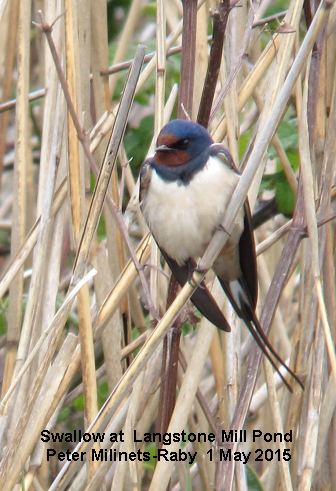
Little Egrets -
I counted 37 nests. Probably the last reliable count
due to the foliage starting to grow! Whilst behind the
mill looking at the Little Egrets nests on the island,
I witnessed a Carrion Crow snatch a Little Egret's egg
from one of the nests and fly off with it. Literally a
minute later, a second Carrion Crow landed on the
unguarded (and probably abandoned) nest and started to
stab at the two remaining eggs and seemingly "drink"
the contents of one of the eggs. I hurriedly set up
the camera and just caught the bird picking up the
third egg and flying off with it (see a very lucky
photo).
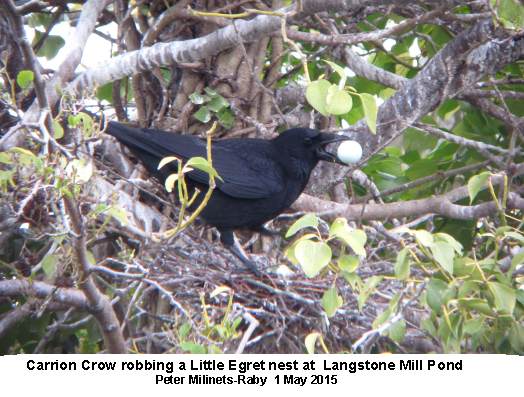
The crow flew over the
mill and landed on the shore. I walked along the path
to view the crow and hopefully get some more photos,
but I accidentally flushed it. The Carrion Crow left
the virtually intact egg on the shore. It was quite
cold. I picked it up temporarily to photo for
identification and scientific purposes and then
destroyed it.
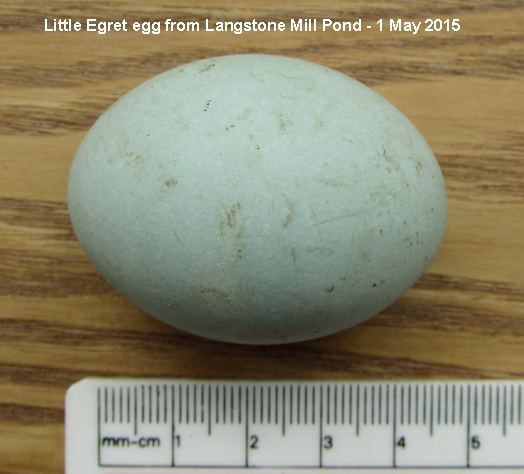
For
earlier observations go to . . April
24-30 . . .